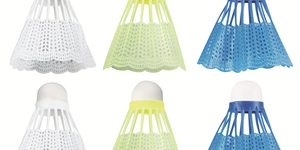The shuttlecock, a critical component of badminton, has undergone significant evolution in its design and materials. In this blog post, we’ll explore the journey of shuttlecock design from its traditional feathered form to the modern synthetic alternatives that have reshaped the sport.
Traditional Feathered Shuttlecocks
For decades, traditional feathered shuttlecocks were the standard in competitive badminton. They are meticulously crafted using goose feathers, cork bases, and intricate hand assembly. Feathered shuttlecocks offer unparalleled flight characteristics, demanding precision and control from players.
The Rise of Synthetic Shuttlecocks
Advancements in materials science led to the development of synthetic shuttlecocks. These shuttlecocks are typically made from nylon or other durable materials. They are designed to be more resilient and long-lasting than feathered shuttlecocks, making them suitable for recreational and training purposes.
Nylon Shuttlecocks
Nylon shuttlecocks are the most common type of synthetic shuttlecock. They are known for their durability and resistance to wear and tear. While they may not replicate the exact flight characteristics of feathered shuttlecocks, they offer consistent performance and are favored for casual play and practice sessions.
Hybrid Shuttlecocks
Some shuttlecock manufacturers have introduced hybrid models that combine feathered and synthetic elements. These shuttlecocks feature feathers in the skirt and synthetic materials in the base. This design aims to strike a balance between the flight characteristics of feathered shuttlecocks and the durability of synthetics.
Eco-Friendly Innovations
In recent years, there has been a push for eco-friendly shuttlecock alternatives. Some manufacturers have explored sustainable materials and manufacturing processes to reduce the environmental impact of shuttlecock production.
Conclusion
The evolution of shuttlecock design reflects the changing needs of badminton players and the sport’s growing popularity. While traditional feathered shuttlecocks remain the choice for competitive play, synthetic alternatives offer durability and accessibility for a wider range of players, ensuring that badminton continues to be enjoyed by enthusiasts of all levels.

























